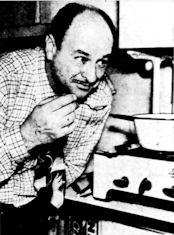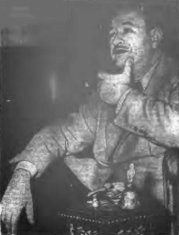|
|
Leonidas Leonardi (Arranger) |
|
Born: July 27, 1901 - Moscow, Russia
Died: March 1, 1967 - New York City, New York, USA |
|
Leonidas [Leonid, Leon] Leonardi was an American composer and pianist of Russian origin. He studied in Paris with Maurice Ravel. In his youth recorded a few commercials as a pianist, for the firms Welte and Pleyel (Pavane for a Dead Princess by Ravel, Franz Liszt, Sergei Rachmaninov, Arensky, Grieg).
Leon Leonardi is known primarily multiple orchestrations - in particular, Chanson Georgienne, Op. 4 No. 4 ("Do not sing, my beauty, for me...") by S. Rachmaninov and especially the cycle Pictures at an Exhibition by Modest Mussorgsky. The most celebrated orchestration of Pictures at an Exhibition was by Maurice Ravel. It was commissioned by the Russian conductor Serge Koussevitzky, who knew of Ravel's admiration for Mussorgsky. The first performance of the French composer's version of Pictures at an Exhibition took place in Paris on May 3, 1923, and it was received with high acclaim. At that time, the publishing firm of W. Bessel & Co., Paris, the first publisher of Pictures at an Exhibition, were still jealously guarding their rights in Mussorgsky's works, and they reluctantly gave Serge Koussevitzky permission Ravel's independently-created orchestral version, on the condition that he would not allow anyone else to conduct it. Their conviction was that an arrangement of one of their piano publications would bring them no commercial advantage.
That Bessel were mistaken became evident as the Ravel orchestration proved ever more successful. Since Serge Koussevitzky was to retain sole proprietary conducting rights in his commission for a period of 5 years, Bessel hastened to bring out a rival orchestration of their own. This they did by approaching a precious 21-year-old Russian pianist named Leonidas Leonardi who was at that time studying orchestration with Ravel himself. Leonardi duly obliged, dedicated his arrangement to Igor Stravinsky. The Leonardi version was more avant-garde nature, prescribed with an orchestra of 60 string instruments, wind instruments of the set, including three saxophones, a large group of percussion. Leonardi himself conducted the premiere of his arrangement with the Lamoureux Orchestra in Paris on June 15, 1924. The USA Premiere took place when the New York Symphony Orchestra played it December 4, 1924 under the baton of Walter Damrosch. Doubtless the publishers were hoping for an even greater triumph from the pupil that had been achieved by the master, but by this they were to be disappointed, since Leonardi's arrangement has remained in virtual obscurity ever since.
Undaunted by the faultier of this particular project, however, Leonidas Leonardi immediately took up residence in the USA to pursue a career as a piano recitalist, composer, conductor and arranger in theatre, films radio and concert hall. He graduated to Broadway musicals, one of which, Bloomer Girl, produced in 1944, he conducted on American Decca in the 'original cast' recording. His Musical career, which lasted until his death in New York in March 1967.
Besides the above mentioned orchestrations and several works by J.S. Bach, a few other orchestral transcriptions by Leonardi are: Dietrich Buxtehude: Prelude BuxWV 142 In E minor; Samuel Scheidt: Cantiones sacrae, Vater unser im Himmelreich. |
|
Article in Presto January 26, 1924 [Arcade Museum] |
|
Leonidas Leonardi joins staff of Welte-Mignon |
|
"By an agreement recently concluded, Leonidas Leonardi, famous young European pianist and composer, will record exclusively for the Welte-Mignon (Licensee). Mr. Leonardi is famous throughout Europe as a pianist, composer and conductor. At twenty-two he has fourteen years of musical triumphs behind him. He made his American debut in a recital at the Academy of Music on January 5, receiving exceptionally enthusiastic press reviews.
The young musician was born in 1901 in Moscow, Russia, and began the study of music at the age of four. His progress was so rapid and his genius so apparent that he became the talk of the court. The Czar expressed a desire to hear the child wonder and after only four years of study, when Leonardi was eight years old, he played before the entire Russian Court the Concerto in C major of Beethoven and was accompanied by the Imperial Symphony Orchestra.
Leonardos father, however, wished his son to acquire a complete education in addition to his music, so he sent the boy to Paris. There he entered the Paris Conservatory in 1913. Among his teachers were Igor Strawinsky for composition and Vincent d'Indy for conducting. In 1918 Leonardi received the Grand Prix d'Honneur of the Conservatory and the first prize in composition. Many other awards were his during his eight years at the Conservatory.
From 1916 to 1922 the young musician gave 800 concerts throughout Europe. He is the author of an opera and three symphonic etudes for piano and orchestra, a poem for the violin, and more than 50 songs and lyric pieces for voice with orchestral accompaniments.
In his debut at the Academy of Music the noted pianist attempted some of the most famous piano classics in the world. It is the interpretation of these compositions that has gained him his reputation as a musical genius and has won for him the applause of the most critical and discriminating of European audiences. |
|



|
|
Source: Russian Wikipedia Website [based on Leonidas Leonardi // Reproducing Piano Roll Foundation; Michael Russ. Mussorgsky, Pictures at an exhibition - Cambridge University Press, 1992. - P. 77.], English translation by Aryeh Oron (October 2009); Liner notes by Edward Johnson (CEO of the Leopold Stokowski Society) to the CD "Mussorgsky: Pictures at an Exhibition - Piano Concerto Version", conducted by Geoffrey Simon (Gala); The Milwaukee Journal (Dec 13, 1944); Death-Record Website
Contributed by Aggelos Tsompanidis (October 2009, January 2010, May 2010; Photos 02-03, May 2013); Aryeh Oron (Dates, May 2013) |
|
Leonidas Leonardi : Short Biography | Orchestral Transcriptions: Works | Recordings |
|
Links to other Sites |
|
Леонарди, Леонидас (Wikipedia) [Russian] |
The Milwaukee Journal - Dec 13, 1944 |
|
Bibliography |
| |
|
|